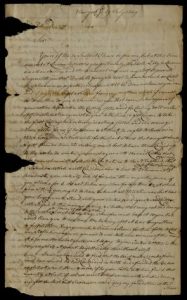In conceptualizing my final project based on the Atlantic Slave Trade I am relying this week on sources from Gilder Lehrman Institute of American History. I chose Gilder Lehrman because they have free, accessible, wide-ranging resources for teacher of U.S. history, particularly for high school courses. I am also using Gilder Lehrman because they have detailed “information architecture” for primary and secondary sources. I will need to check for guidelines on reuse, but my hope is to mine resources from their organization in order to create consistency in terms of format, metadata, and scholarship.
Here is a sample of some of their full-text scanned and transcribed primary sources: https://www.gilderlehrman.org/featured-primary-sources
I selected this text by Robert Livingston because it presents a different view of slavery and slaveholders who sold and purchased kidnapped African men and women. In addition to having a scanned high resolution for students to transcribe, there is also a full transcript available on the site. This would challenge students to dissect the writing before analyzing the language itself and the text’s meaning in its day versus present-day.
As Gilder Lehrman Institute of American History states, “Livingston’s callous description demonstrates the slave-trade investor’s emphasis on the financial loss, rather than the human cost.” This is highlighted in the following excerpt:
We have thank God had the good fortune of haveing one of our Guinea Sloops come in, tho after along passage of 79 days in which time they buryed 37 Slaves & Since 3 more & 2 more likely to die which is an accident not to be helped, and which if had not happend we Should have made a Golden Voyage but as it is there will not be much left I fear, unless the other Sloop meets with better Luck
Robert Livingston to Petrus Dewitt, July 29, 1749. (The Gilder Lehrman Institute of American History, GLC03107.04449)
Additional resource: Myths and Misconceptions on the Slave Trade

